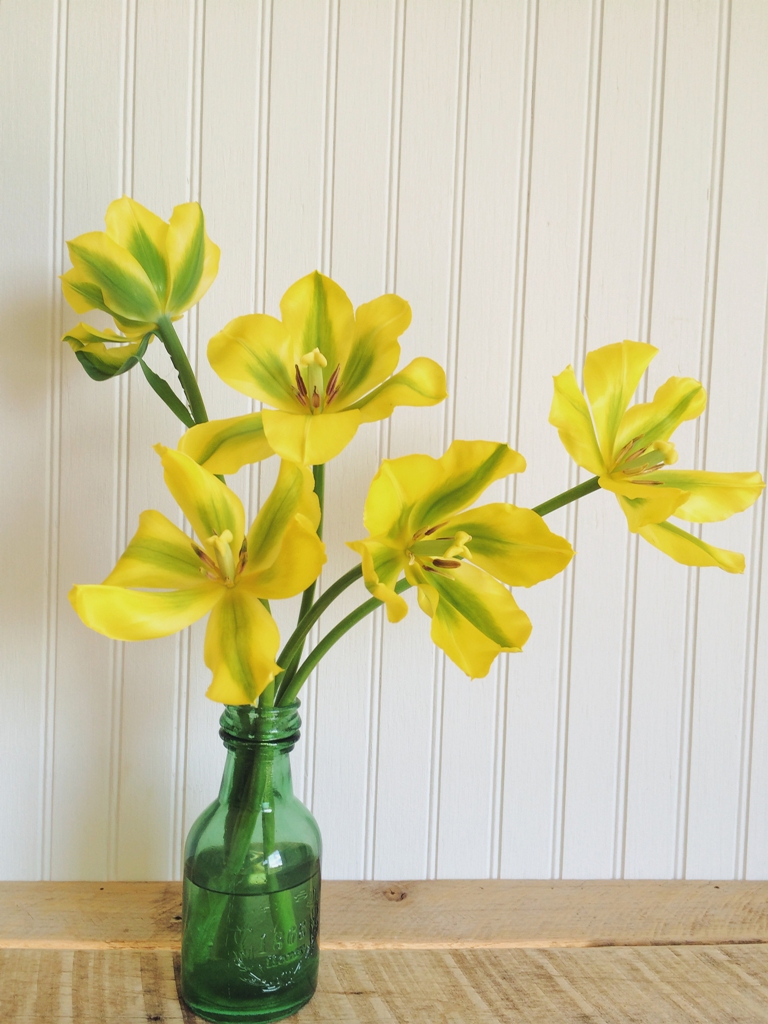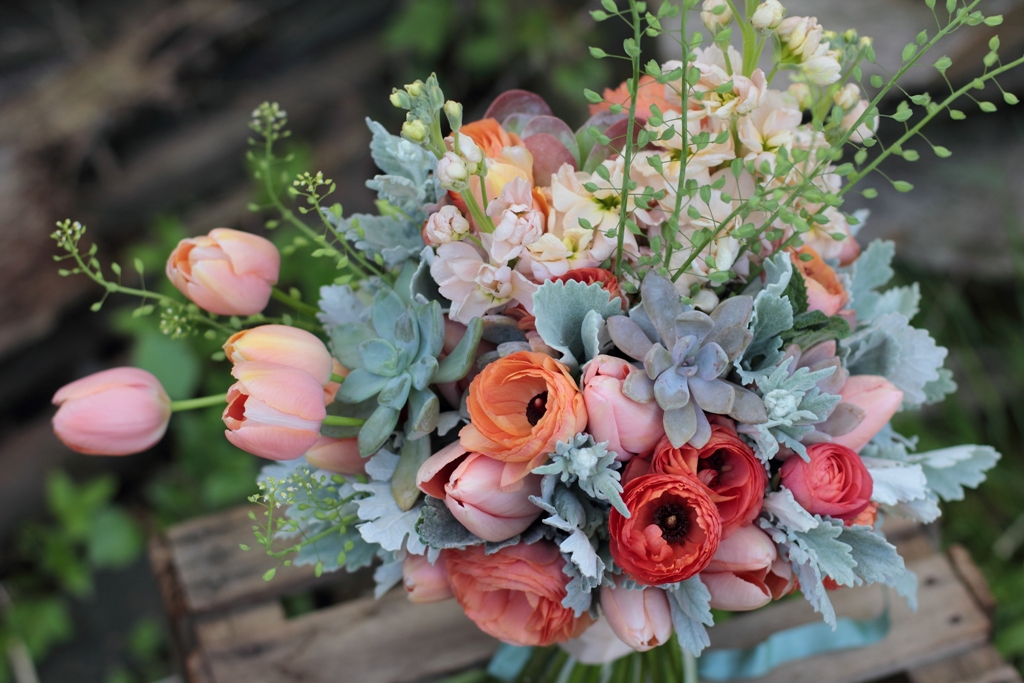When I first started flower farming, I heard a lot of experienced growers talk about how there was no money to be made in tulips. I could see that. Walk into a supermarket in April here in Philadelphia, and you can grab a decent looking (albeit boring) bunch of tulips for less than five bucks. When you do the math on that, a typical small-scale farmer is unlikely to make a profit on selling tulips to grocery stores, farmers markets, or florists. I ignored tulips for my first two seasons as a result.

As I got more immersed in wedding work, I needed reliable early spring blooms. So I circled back to tulips and decided that if I was going to grow them, I’d pick ones unlikely to show up at the supermarket so my couples would be getting something really unique. The bulbs for these varieties are not cheap. The range for my order this year, when buying in quantities of 500-1000 per variety, was 18 to 45 cents per bulb. Tack on shipping, and it’s a bit of an investment.

If you’re doing wedding work with your flowers, growing unique tulips is a no-brainer. You can easily recoup the cost of the bulb and your time growing, plus make a tidy profit. The key is to pay attention to the color trends and/or book your weddings as far out as possible so you know what you are planting is going to be an easy sell to your brides. Peach, white, cream, and soft yellow are always popular for spring weddings so those are safe bets.

If selling flowers to florists, farmers markets, or grocery stores, you may still be thinking tulips are not for you. Granted, it’s not going to be a huge money maker, but there is some merit in it, I promise! I discovered purely by accident how great a crop they can be for just such sales outlets.
My first season of growing tulips for cuts I didn’t really know what to expect or when they would be ready. I sheepishly admit to not believing the experienced growers who told me they’d all be ready at once, literally come and done in about a week unless I had chosen varieties carefully to extend that window. So one warm day I walked into my field and realized I had about 1000 tulips all ready and nowhere to sell them! I did not have a cooler at the time so holding them all was not an option. The wedding I had grown them for was the following week, and I figured I could save the tightest blooms for that in a refrigerator I had in my basement. But I still had about 800 fairly open tulips that needed a home. They were beautiful lily and French varieties in complimentary shades and all were a good three feet tall, some taller. I could not let such a great crop go to waste!

I called up my only grocery store at the time, which I had only sold a handful of bunches to previously so I was decidedly nervous. I knew that tulips were going to be a hard item to push. The buyer said to bring them over and she would take a look. The moment I pulled them out of my van, she was sold. They were like nothing she had seen before and she was confident customers would love them. I sold them cheap to get them of my hands, not really making any profit. But it had a magical affect on the customers at that grocery store. They were smitten. They clamored for more! The buyer begged me to grow more the following year. And tulips have become a consistent, sold-out, spring crop for us ever since.

Tulips grown on a small-scale farm like ours are what some might call a “loss leader”. Those of you with marketing or retail backgrounds probably know this term already. Basically it’s a technique employed by businesses sometimes to suck in customers. It is an item, usually in abundance, that is marked at a low price, sometimes at a true loss, but ideally with a bit of profit still. The idea is that a customer will come in for that inexpensive item and get hooked on your business or buy a lot of other stuff at the same time, creating a profit in the long-run.

With tulips you will reach your customers earlier in the season so they will get into the habit of buying from you instead of someone else. Tulips have an incredible vase life that is pretty foolproof so customers will associate you with having the most amazing, long-lasting blooms. And tulips can be growing all winter long in beds that would otherwise be empty, then plucked out to sell and the bed immediately turned over into a new crop with very little downtime. Planting them tightly in trenches is relatively fast and easy (we plant thousands in one afternoon) and picking/processing is also fast and easy.

If you are selective in your varieties and invest in some of the more unique (and, yes, pricier) ones, like “peony” or double tulips, you can charge a premium price, especially if you sell to florists who are very excited by the double varieties. Parrot tulips can also be a good investment, but they are becoming more mainstream for florists so choose colors that are unusual and not likely to be available from their wholesalers.

There are quite a number of bulb suppliers, and I have used several. Ednie is great and not as pricey as some, especially if you live on the East Coast so shipping isn’t as expensive. Gloeckner, Botanical Trading Company, and Netherland Bulbs are also suppliers to look into. I have personally enjoyed working with Our American Roots out in Washington state. Great customer service!!! Tell Shannon I sent you!
Before placing an order, check on shipping to you as that may make the price per bulb more than you want to pay. Shop around and find the right combination of varieties and prices and then order from one supplier so you can get quantity discounts. Bulbs should be ordered late spring or early summer so order soon if you have not already.

Some favorite varieties that we grow at Menton, Maureen, Spring Green, Renown Unique, Gudoshnik, and Black Hero.
I suspect most of you know, but for newer growers who have not tackled tulips before, you harvest by pulling them out of the ground, not cutting. This gives you added stem length and makes bed clean-up easier. If you are really determined, you can try to save the bulbs and get them to come back, but the quality is never good and many will die. Do yourself a favor, and just compost those old bulbs and order more for the next season. Tulips should be rotated to avoid disease build up in the soil.

Tulips can be stored for quite a long time in the cooler. We have kept them in the cooler for over a month. Pick them at “color crack” (when the bud just opens enough so there is a slit of color) for longest storage life. We store ours wrapped tightly in newspaper standing straight up in a Procona bucket, no water. We jam as many into a Procona as possible to help keep their stems straight. When ready to use, we pull them out a day ahead and snip an inch off their stems and put in a deep bucket of cool water so they get a really good drink. Remember that tulips will continue to grow in the vase so if you are designing for a wedding, put your tulips way down in the arrangements so when it’s “show time”, they’ll be at the right height, not towering oddly over the other flowers.
So, will you reconsider the tulip?

Thanks for the tulip blog and tutorial Jennie! I hadn’t known about pulling them out and how they don’t do well in their following years. Have you ever donated old bulbs to community gardens and such? I feel like that might be another good way to reuse them (vs composting).
Thanks for the great post about tulips. We had the same experience with all ours ready at once. Because this was our first time with tulips and we didn’t expect that, and because we were growing off site, we lost a lot of the crop. Without a cooler or fridge for storage, this crop is on hold, but we are hooked and will grow them again as soon as we can. Thanks for suggesting the sales strategies and outlets. We always love reading your suggestions.
I had always avoided tulips also. You have peaked my interest again. I may try this thing called tulip-mania! Thanks for the inspiration Jenny!
What a great article! So easy to follow for a newbie grower and you sucked me right in. I cannot wait to experiment with Tulips next Spring!
I have been a florist for most of my life…. and that’s a long time.. lol I never knew you could store tulips so long. I have recently started growing some cut flowers. This info is so good thank you for sharing I will be back…. 🙂
Can you share how you quickly plant so many in trenches? I may have ordered 800 for this fall and am feeling a but frightened at the planting! Btw I’m a hobby grower and have always adored tulips. They’re magical looking.
Hi Mara – We just till the soil then use a shovel to dig out the trench, heaping the dug soil onto a tarp so it’s easy to shovel it back into the trench when we are done placing the bulbs. It’s really as easy as it sounds. Nothing fancy or complicated about it. Way faster than digging a little hole for each individual bulb.
Hey Jennie, just re-reading this article as I consider my bulb order. As always, thanks for the great info!!
How about the little “sports” that may bloom if you don’t pull them up at harvest time–are these second blooms not worth waiting for, profit wise? I know they’re much smaller but they are so dear. Curious if you’ve tried to sell these too before deciding it wasn’t worth it.
Thanks!
What beautiful tulips! I am just stumbling upon this article now but I had no idea there was such a variety of tulips! There really is no comparison between these and the supermarket crap.
What is a good price to sell the exotic varieties? And how big is a bunch?
Jenny- just a quick note to tell you that I took a leap of faith this Mother’s Day by sending a handful of dry tulips that I had grown by mail to my favorite mothers (IE: mother and MIL) based on this blog post. What a hit! The tulips arrived in perfect condition and both mothers were thrilled! I’m not sure I would have tried it if it wasn’t for this post. Thank you for the encouragement!
Elizabeth
Hi,
What do you think of the supplier Dutch Grown?
Megan
I like them! We’ve been ordering our tulip and narcissus bulbs from them the past two years. Great guys!
Thank you for this article! I woke up one morning and becoming a tulip farmer popped into my head. Where did that came from? I have no clue! Lol But I’ve been at a crossroad in my life, where I’ve been an X-Ray technologist for 14+ years, and I’m just tired of working for doctors and administrators that treat you badly.
Also, having a 100% Dutch dad, tulips are definitely a staple in my life. But me be a tulip farmer? I think God whispered that in my ear. Sorry for my rambling, but thank you again for your article.
How do you protect the bulbs from critters?